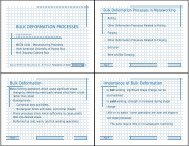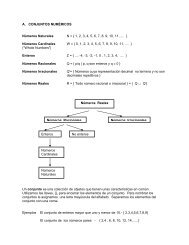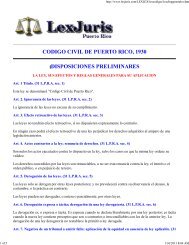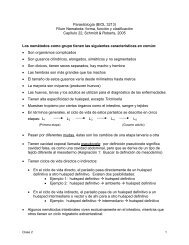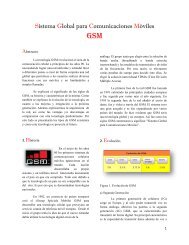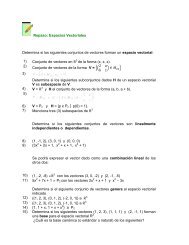FEEDBACK CONTROL, DESIGN PROCESS
FEEDBACK CONTROL, DESIGN PROCESS
FEEDBACK CONTROL, DESIGN PROCESS
Create successful ePaper yourself
Turn your PDF publications into a flip-book with our unique Google optimized e-Paper software.
<strong>FEEDBACK</strong> <strong>CONTROL</strong>, <strong>DESIGN</strong><br />
<strong>PROCESS</strong><br />
AMILCAR RINCON CHARRIS<br />
MECN 4610
Unity feedback system
SECOND ORDER CLOSED LOOP
PID <strong>CONTROL</strong>LER<br />
Kp = Proportional gain<br />
KI = Integral gain<br />
Kd = Derivative gain
<strong>CONTROL</strong> SIGNAL<br />
The variable (e) represents the tracking error, the difference between the<br />
desired input value (R) and the actual output (Y). This error signal (e) will<br />
be sent to the PID controller, and the controller computes both the<br />
derivative and the integral of this error signal. The signal (u) just past the<br />
controller is now equal to the proportional gain (Kp) times the magnitude<br />
of the error plus the integral gain (Ki) times the integral of the error plus<br />
the derivative gain (Kd) times the derivative of the error.
Example Problem<br />
M = 1kg<br />
b = 10 N.s/m<br />
k = 20 N/m<br />
F(s) = 1<br />
The goal of this problem is to show you how each of Kp, Ki and Kd contributes to obtain<br />
•Fast rise time<br />
•Minimum overshoot<br />
•No steady‐state state error
Open‐loop step response
Open‐loop step response MUX
Proportional Controller
Kp=10
Kp=50, 100, 200, 1000
Effects of controllers Kp<br />
•A proportional controller (Kp) will have the effect of<br />
reducing the rise time and will reduce ,but never<br />
eliminate, the steady‐state error.<br />
CL RESPONSE RISE TIME OVERSHOOT<br />
SETTLING<br />
TIME<br />
S‐S ERROR<br />
Kp Decrease Increase Small Change Decrease
PI Controller
Effects of controllers Ki<br />
•An integral control (Ki) will have the effect of eliminating<br />
the steady‐statestate error, but it may make the transient<br />
response worse.<br />
CL RESPONSE RISE TIME OVERSHOOT<br />
SETTLING<br />
TIME<br />
S‐S ERROR<br />
Ki Decrease Increase Increase Eliminate
PD Controller
Effects of controllers Kd<br />
•A derivative control (Kd) will have the effect of<br />
increasing the stability of the system, reducing the<br />
overshoot, and improving the transient response.<br />
CL RESPONSE RISE TIME OVERSHOOT<br />
SETTLING<br />
TIME<br />
S‐S ERROR<br />
Kd Small Change Decrease Decrease Small Change
PID <strong>CONTROL</strong>LER
Effects of each of controllers Kp, Kd, Ki<br />
•A proportional controller (Kp) will have the effect of reducing the rise time and will<br />
reduce ,but never eliminate, the steady‐state error.<br />
•An integral control (Ki) will have the effect of eliminating i i the steady‐state error, but it<br />
may make the transient response worse.<br />
•A derivative control (Kd) will have the effect of increasing the stability of the system,<br />
reducing the overshoot, and improving the transient response.<br />
CL RESPONSE RISE TIME OVERSHOOT<br />
SETTLING<br />
TIME<br />
S‐S ERROR<br />
Kp Decrease Increase Small Change Decrease<br />
Ki Decrease Increase Increase Eliminate<br />
Kd Small Change Decrease Decrease Small Change
General tips for designing a PID<br />
controller<br />
When you are designing a PID controller for a given system,<br />
follow the steps shown below to obtain a desired response.<br />
• Obtain an open‐loop response and determine what needs<br />
to be improved<br />
• Add a proportional control to improve the rise time<br />
• Add a derivative control to improve the overshoot<br />
• Add an integral control to eliminate the steady‐state error<br />
• Adjust each of Kp, Ki, and Kd until you obtain a desired<br />
overall response. You can always refer to the tbl table shown in<br />
this "PID Tutorial" page to find out which controller controls<br />
what characteristics.






